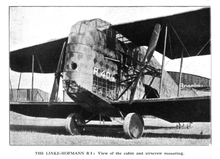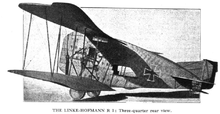Linke-Hofmann R types
The Linke Hofmann R-Types were extremely heavy long-range bombers of the German air force in the First World War .
The multi-engine R aircraft were used as long-range bombers with long range and heavy bomb load for strategic bombing. Since the German airship attacks were reduced and finally stopped due to heavy losses , giant aircraft on an even larger scale than before should be used and fill this gap. This goal was not achieved, the bombers were no longer used in combat.
History and construction
The Linke Hofmann company , aircraft construction department, has dealt with the license production of Albatros and Roland two-seaters since 1916 . However, chief engineer Paul Stumpf, who had already gained experience in aircraft construction at AEG , soon began developing giant aircraft himself.
The prototype (R.8 / 14?) Was produced by Linke Hofmann RI . It was a huge biplane , the two propellers of which were driven by four motors housed in the fuselage. The very high fuselage completely filled the space between the two wings and was covered with a transparent cellon cover, a celluloid- like plastic cover, to make the aircraft as difficult to see as possible. The cellon cover did not prove itself, however, as it reflected the sunlight and changed its expansion depending on the temperature. In the case of the R.40 / 16, the normal Lozenge camouflage fabric that was generally used towards the end of the war was used. The front part of the fuselage was divided into three horizontal compartments: the upper part for the pilot and the radiotelegraph , below the engines and below the fuel tanks and the bomb bay with the bombardier. The motors acted on a common transmission, which transmitted the power via a shaft to the two pairs of push and pull propellers between the wings. The poor flight characteristics of this aircraft construction were hardly controllable for the pilot.
From the left Hofmann R.II two prototypes R.55 / 17 and R.58 / 17 were built. It was designed based on the model of the tried and tested DFW CV on a scale of 3: 1, but the horizontal stabilizer was double-decked and the side surfaces were designed three times and a horn compensation was added to the ailerons . The wheels were spoked steel wheels without tires. The price of the plane was 450,000 RM. The “engine room” resembled that of a ship. The four 260 hp Mercedes D-IVa engines, arranged in pairs in the fuselage, drove a pulling propeller with a diameter of 6.90 m via couplings, shafts and gears. A propeller with a larger diameter has never been used in any aircraft. The bomb room was located below the engine room. The rest of the crew found space behind the engine room on two decks, where there were two side-by-side rotating rings for machine guns on the upper deck, in addition to the two open pilot seats . Below the pilot's room was the place of the bombardier and the radio operator and the installation of a rotating short-barreled howitzer was also considered, an anticipation of the later gunships . The R.II showed significantly better flight characteristics than its predecessor. The coordination of the rudder forces was also very good and in the magazine " Flugsport " from 1919 they are compared with those of a C-airplane (initial model DFW CV). The fact that it could be controlled with one hand by just one pilot without any signs of fatigue is particularly emphasized here. Plans to develop it as a 12-passenger airliner after the war were abandoned due to the provisions of the Versailles Peace Treaty .
commitment
The flight performance of the RI was disappointing. Landing was particularly difficult as the pilot could barely see the ground below. The wing vibration also bothered the pilot. Nevertheless, Linke-Hofmann received the order to build the second aircraft (R.40 / 16). However, it is unclear whether the RI was even used. The R.14 belonged to Giant Aircraft Division 500 (RFA 500, established on January 31, 1916, renamed Giant Aircraft Division 501 on October 23, 1918). It took off on August 19, 1917 from the Halberstadt airfield and crashed in the Klusberg near Halberstadt . All 6 crew members died (Aviator Karl Ebert, Vice Sergeant Heinrich Eismann, Private Paul Munk, Observer Lt. Karl Plagermann, Pilot Oberlt. Effrem Rosetti-Solescu, Friedrich Windgassen), as can be read on the memorial there.
The R.II was no longer ready for the front. The first flight of the R.55 / 17 took place in 1919 after the armistice during the inspection of the air troops. She showed acceptable flight performance and maneuverability, was easy to fly with only two engines. The normal operating time was 7 hours, but with an adjustment of the load and a flight speed of only 119 km / h a flight time of 30 hours was possible.
Technical specifications
| Parameter | RI | R.II |
|---|---|---|
| Construction year | 1915/1916 | 1916/1918 |
| Intended use | bomber | |
| crew | 6-9 | |
| length | 15.56 m | 20.33 m |
| span | 32.02 m | 42.16 m |
| height | 6.78 m | 6.70 m |
| Wing area | 264.0 m² | 320.0 m² |
| Empty mass | 5,800 kg | 8,000 kg |
| Takeoff mass | 9,000 kg | 11,200 kg |
| water-cooled in- line engines | 4 × Mercedes D.IVa each with 260 PS (approx. 190 kW) | |
| Top speed | 130 km / h | |
| Ascent time to 3000 m | 45 min | |
| Service ceiling | ||
| Range | 1,040 km | |
| Flight duration | 4 h | |
| Armament | 4 MG , 1000 kg bombs | 4 MG |
See also
literature
- Brian Cooper, John Batchelor: Bombers 1914-1939. Phoebus Publishing Company, London undated, ( Purnell's history of the world wars special ).
- George W. Haddow, Peter M. Grosz: The German Giants. The Story of the R-planes, 1914-1919. Putnam & Company Limited, London 1962.
- Günter Kroschel, Helmut Stützer: The German military aircraft 1910–1918. Lohse-Eissing, Wilhelmshaven 1977, ISBN 3-920602-18-8 .
- Heinz Nowarra: The Development of Airplanes 1914–1918. Lehmanns, Munich 1959.
- Karl R. Pawlas: German aircraft. 1914-1918. A documentation. Pawlas, Nuremberg 1976, ISBN 3-88088-209-6 , ( Aviation Documents 20).
Web links
- image
- Photo of the Linke-Hofmann works
- Photo of the RI with Cellon covering
- Aerial view of the R.II ( Memento from November 18, 2008 in the Internet Archive )
Individual references / comments
- ↑ cf. Information in the engl. Wikipedia
- ↑ cf. Image 333 from Karl R. Pawlas: German aircraft 1914–18. Nuremberg 1976
- ↑ cf. Guinness Book of Records according to Archived copy ( Memento of the original from May 16, 2008 in the Internet Archive ) Info: The archive link was automatically inserted and not yet checked. Please check the original and archive link according to the instructions and then remove this notice.
- ↑ a b c d Partly contradicting information; here according to Nowarra, Heinz: The Development of Aircraft 1914–18 , Munich 1959



